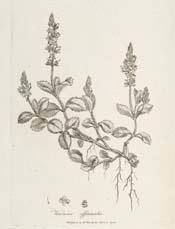

|
Common Gypsyweed
(Veronica officinalis LINN.)
|
Speedwell, Common
Botanical: Veronica officinalis (LINN.)
Family: N.O. Scrophulariaceae
---Part Used---Herb.
The Common Speedwell is a native of the Old World, but is abundantly naturalized in the eastern United States, where it grows in open, grassy places.
In this country, it is generally found on heaths, moors, dry hedgebanks and in coppices, where it is very common and generally distributed.
---Description---The plant is a perennial, of a prostrate habit, with ascending branches, bearing erect, spike-like clusters of blue flowers, the stems 3 to 18 inches long, varying very much in length according to soil. The leaves are opposite, shortly stalked, generally about an inch long, oval and attenuated into their foot-stalks, their margins finely toothed. The flowers are in dense, axillary, manyflowered racemes, 1 1/2 to 6 inches long, the individual flowers nearly stalkless on the main flower-stalk, their corollas only 1/6 inch across, pale blue with dark blue stripes and bearing two stamens with a very long style. The capsule is inversely heart-shaped and notched, longer than the oblong, narrow sepals. The plant is of a dull green and is generally slightly hairy, having short hairs, sometimes smooth.
The fresh herb is faintly aromatic. After drying, it is inodorous. It has a bitterish, warm, and somewhat astringent taste.
---Constituents---Enz found a bitter principle, soluble in water and alcohol, but scarcely so in ether, and precipitated by the salts of lead, but not by tannic acid; an acrid principle; red colouring matter, a variety of tannic acid, producing a green colour with ferric salts; a crystallizable, fatty acid, with malic, tartaric, citric, acetic and lactic acids; mannite; a soft, dark green bitter resin.
Mayer, of New York (in 1863), found evidences of an alkaloid and of a saponaceous principle. Vintilesco (1910) found a glucoside both in this species and in Veronica chamaedrys.
---Medicinal Action and Uses---This species of Veronica retained a place among our recognized remedies until a comparatively late period, and is still employed in herbal medicine.
Its leaves possess astringency and bitterness.
Among the Welsh peasantry, great virtues are attributed to the Speedwell. The plant has diaphoretic, alterative, diuretic, expectorant and tonic properties, and was formerly employed in pectoral and nephritic complaints, haemorrhages, diseases of the skin and in the treatment of wounds. Modern herbalists still consider that an infusion of the dried plant is useful in coughs, catarrh, etc., and is a simple and effective remedy in skin diseases.
[Top]
---Other Species---
In Familiar Wild Flowers (and also inLindley's Treasury of Botany) mention is made of another Speedwell called 'Buxbaum's Speedwell' (V. Buxbaumii) which the author states is sometimes mistaken for V. Agrestis, but is a distinct species. It branches freely and attains to a height of a foot or so; its stem and leaves are thickly clothed with soft and silky hairs. The leaves are placed singly at irregular intervals along the stem, but are more numerous towards the summit; they are broadly heart-shaped, with margins deeply-cut into teeth, each leaf has a short leaf-stalk; all leaves are of the same character. The flower-bearing stems that spring from the axils of the leaves are very long, and give a decided character to the plant, while the flowers themselves have the curious Veronica character - three large and fairly equal segments and then a lower and narrower one. The blossoms are a clear blue in colour, and for a Veronica are decidedly large. The fruit or capsule that succeeds the flower is twice as broad as it is long, and this flattened-out character is a specific feature. It derived its name from a distinguished botanist of the eighteenth century.
Buxbaum's Speedwell is a plant of cultivation, springing up in gardens and fields, and never far from human society and influence. It is a southerner, and though found throughout England and even Southern Scotland, it is more at home in less northern latitudes, and was probably introduced with some kind of foreign seed.
V. Serpyllifolia (Thyme-leaved Speedwell); the Marsh Speedwell (V. scutellata); the Ivy-leaved Speedwell (V. hederifolia); the Procumbent Speedwell (V. agrestis); and the Wall Speedwell (V. arvensis).
The Spiked Speedwell (V. spicata) is decidedly rare, but a handsome species; the Rock Veronica (V. saxatilis), a fine species with few flowers, is chiefly found in the highlands of Scotland.
Three other extremely rare species are V. verna (Vernal Speedwell), V. alpina (Alpine Speedwell) and V. triphyllos (The Finger Speedwell).
See VERONICAS.
[Top]
Common Name Index
A MODERN HERBAL Home Page
Bear in mind "A Modern Herbal" was written with the conventional wisdom of the early 1900's. This should be taken into account as some of the information may now be considered inaccurate, or not in accordance with modern medicine.
© Copyright Protected 1995-2004 botanical.com

|

